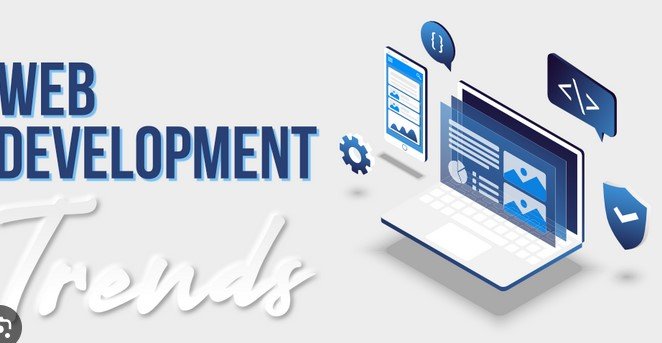Trends in Web Development for 2025
Web development is an ever-evolving field, with new technologies and design trends emerging every year. As we look ahead to 2025, several key trends are set to shape the future of the web. From advanced artificial intelligence (AI) integration to the rise of voice search optimization, web development will continue to push the boundaries of innovation. In this post, we will explore the top web development trends for 2025.

Technology Solutions and Online Entertainment
Xenex BD provides innovative tech services to help businesses thrive in the digital age. For a well-deserved break, try the exciting and strategic game of online baccarat and enjoy some engaging online fun.
Artificial Intelligence and Machine Learning Integration
One of the biggest trends in web development for 2025 is the deeper integration of artificial intelligence (AI) and machine learning (ML). These technologies are already being used for personalization, content recommendations, and automation. However, by 2025, AI will be much more embedded in web development.
Websites will become smarter, using AI to offer tailored experiences for users. Machine learning algorithms will allow websites to analyze user behavior and adapt the content in real-time. For example, AI-powered chatbots will offer more natural interactions, and predictive search features will help users find what they need faster. This trend will enhance user engagement and improve customer service on websites.
Next-Level Digital Experiences with Real-Time Interactivity
In a world driven by cutting-edge tech solutions, the rise of live dealer casino games showcases how real-time engagement and innovation go hand in hand. These immersive platforms reflect the same commitment to seamless user experiences that defines XenexBD’s digital services.
Progressive Web Apps (PWAs) Gaining Popularity
Progressive Web Apps (PWAs) will continue to rise in popularity as a trend in web development. PWAs combine the best features of websites and mobile apps, offering users the ability to interact with a website offline, receive push notifications, and enjoy faster load times. In 2025, PWAs will become even more advanced and accessible.
PWAs allow users to have a seamless experience across devices without the need to download an app from an app store. With the increasing importance of mobile optimization, PWAs offer a hybrid solution that works efficiently across all platforms. Expect more businesses to adopt PWAs as they look to provide faster, more responsive websites to meet the growing demand for mobile-friendly solutions.
Voice Search and Voice User Interface (VUI)
Voice search and Voice User Interface (VUI) are expected to be major trends in web development by 2025. With the growth of voice assistants like Amazon Alexa, Google Assistant, and Apple Siri, voice search is becoming a dominant method of interaction with devices. Web developers will need to adapt their websites to accommodate voice-based queries.
In 2025, optimizing websites for voice search will be critical for businesses. This means using conversational keywords, focusing on natural language processing (NLP), and ensuring that websites are easily navigable through voice commands. Websites will also need to offer more accessible VUI, allowing users to interact with web applications using voice commands for a more hands-free experience.
Augmented Reality (AR) and Virtual Reality (VR) Integration
Augmented Reality (AR) and Virtual Reality (VR) technologies are increasingly being integrated into web development. By 2025, it’s expected that these immersive technologies will be a common part of many websites, especially in sectors like e-commerce, real estate, and education.
For example, users could try on clothes virtually through an AR feature or take a virtual tour of a property. With the help of AR and VR, web developers will be able to create more engaging and interactive user experiences. As AR/VR hardware becomes more affordable and accessible, expect to see more websites incorporating these technologies to stand out in the competitive online landscape.
Motion UI and Dynamic Interactions
In 2025, websites will continue to prioritize dynamic and engaging user experiences. Motion UI—the use of animations, transitions, and other interactive elements—will be an essential component in web development. These dynamic interactions will not only make websites more visually appealing but will also contribute to improved usability.
Developers will use micro-interactions, subtle animations, and scrolling effects to guide users through a website, making the experience more intuitive and enjoyable. Motion UI helps grab the user’s attention, provides feedback on user actions, and enhances the overall user experience. As web design continues to focus on aesthetic appeal, expect motion UI to play a key role in engaging users.
Serverless Architecture and Edge Computing
Serverless architecture and edge computing are two trends that will continue to grow in importance in 2025. This architecture allows developers to build and run applications without managing the underlying infrastructure. This means developers can focus more on creating features and improving user experiences, rather than worrying about server management.
Edge computing, on the other hand, involves processing data closer to the user, reducing latency and improving website speed. By distributing data across multiple locations, websites can load faster, especially for users located far from the server. Both serverless architecture and edge computing will help streamline web development processes, improve performance, and deliver faster websites to users.
Exploring Technology and Entertainment
Xenex BD provides IT solutions and software services. For those seeking diverse online entertainment, consider exploring real money casino australia. Xenex BD remains focused on delivering technology-driven solutions.
“`
Conclusion
As we approach 2025, web development is set to undergo exciting transformations. From AI-driven personalization to immersive AR/VR experiences, the future of the web promises to be more dynamic, intuitive, and user-focused. To stay ahead of the competition, web developers will need to embrace these trends and continually adapt to the evolving digital landscape. By leveraging the latest technologies and focusing on enhanced user experiences, businesses can build websites that are both innovative and impactful.



